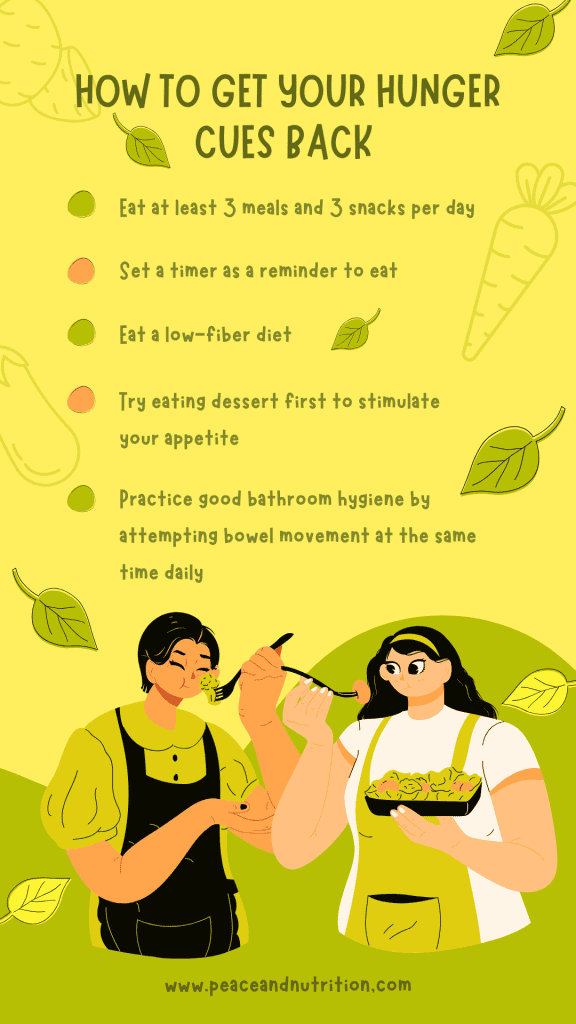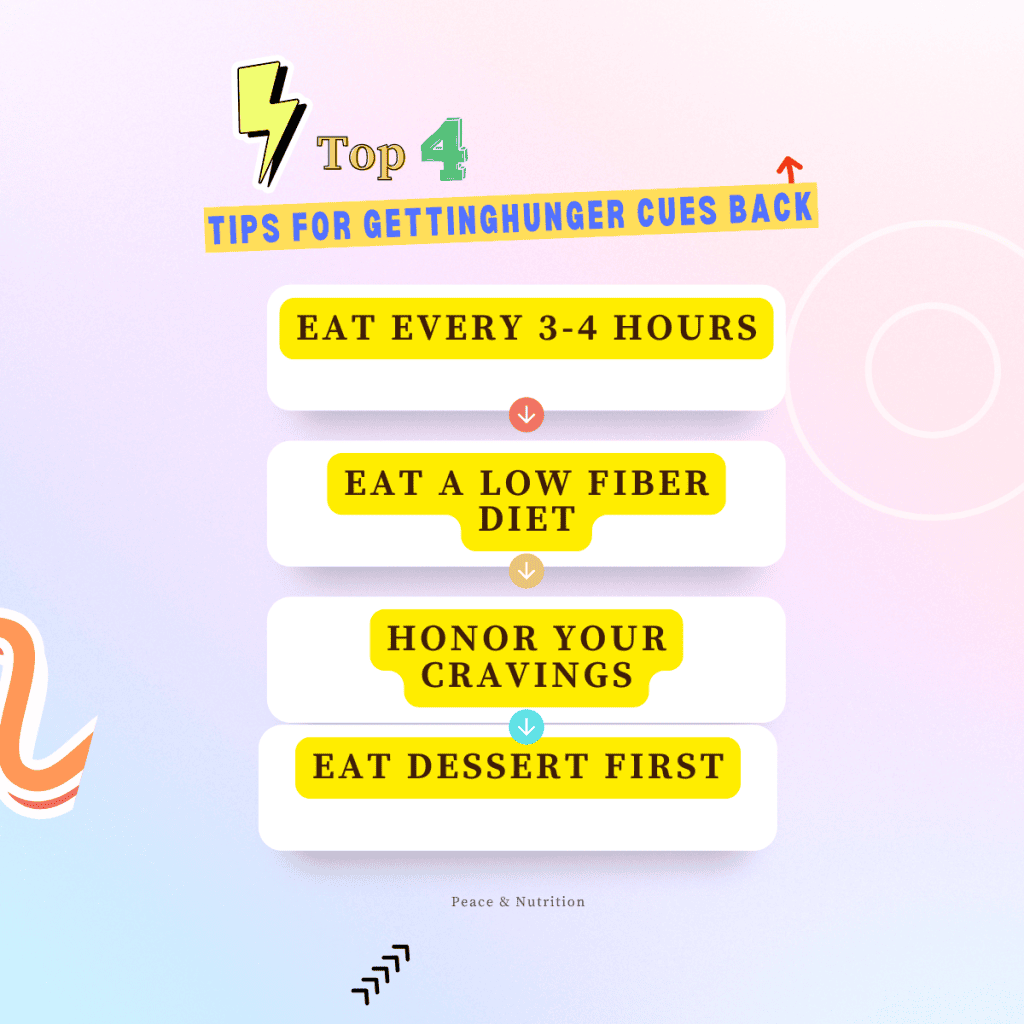Table of Contents
Last updated on June 14th, 2025 at 04:10 pm
It can feel impossible to get your hunger cues back after an eating disorder.
You might be getting frustrated by the fact that despite giving it your all in weight restoration you’re:
- Getting full fast
- Having no cravings for food
- Having a difficult time meeting your meal plan
To top it off, your eating disorder voice is likely still causing you to experience extreme guilt after eating.
This article will help you to pinpoint why your hunger cues are absent after an eating disorder and how to get them back. We’ll work through some of the emotional and physical barriers to getting hunger cues back.

Why My Hunger Signals Are Messed Up
Starving yourself will cause your body to stop giving you hunger cues altogether. Your body is under a lot of physical and emotional stress. It starts to think “well, you aren’t feeding me anyways, I don’t have the energy to waste telling you when you need to eat.”
Your body will not produce the normal metabolic responses that it had prior to starvation in response to food stimuli. This means, your hunger cues will likely be non existent.
Here’s some of the nitty gritty behind why the body starts to shut down your hunger cues:
- Increased activation of the right cerebellum which results in decreased sensory processing in response to food
- Starvation causes decreased SEM (startle eyeblink motivation) which reduces your appetite response to food
- Your digestion slows to a halt, and you probably have some gastroparesis
- You have a decrease in enzymes and hormones associated with hunger as a response to starvation
How Do I Get My Hunger Cues Back
Hunger cues are helpful, but they’re not necessary to eat. In fact, the only way to get your hunger cues back Is to eat. While it might seem counterintuitive, eating when you’re not hungry is the name of the game for both recovering from your eating disorder and getting your hunger cues back.
Here’s the 5 steps to getting your hunger cues back:
- Following a mechanical eating plan (A structured meal plan provided by your ED RD. This not the time for intuitive eating (because you literally can’t. There’s nothing intuitive happening in your body right now)
- Eat at least 3 meals and 3 snacks per day
- Set a timer as a reminder to eat and treat each meal like an appointment (you might not remember on your own or your ED Voice will talk you out of it)
- Try eating dessert first to stimulate your appetite
- Eat a low-fiber diet to start with (this will help you not feel so full and also increase your total energy intake through the day)
- Practice good bathroom hygiene by attempting a bowel movement at the same time daily (regular bowel movements will help with feeling overly full)
- Have a relaxation routine you do before meals. This may include breathing, meditation, journaling, or a calming activity such as crocheting.
- Try making some of your calories liquid calories to start (this doesn’t require as much use of the atrophied digestive muscles in the beginning)
- Eat with someone else if possible
- Get in some gentle movement if it’s approved by your healthcare team to help stimulate the appetite

Foods To Eat If You Have No Hunger Cues
While you probably aren’t particularly craving food in those initial stages of eating disorder recovery, here are some foods that might help you get those hunger cues back a little faster or go down a little easier.
- Smoothies, Supplemental shakes or protein shakes: These foods do not require as muchdigestion
- Yogurt
- Simple sugar foods (sodas, juices, candy) : These foods are often the first thing we crave after starvation because the body knows it can break down the sugar quickly and use it right away
- Desserts of Fats: These have more calories for less volume which means you don’t have to eat as much of them to get your energy needs in
- Simple foods: Keep crackers, cookies and other goodies on hand
- Low effort meals: I recommend keeping a freezer fully stocked with frozen meals that meet hor meal plan, sandwich ingredients and other very low prep foods. The last thing you’re going to want to do if you don’t have hunger cues is spend a lot of time making a meal

How Long Does It Take To Get Hunger Cues Back After an ED
It normally takes between six weeks to a year to get your hunger cues back after an eating disorder.
The process to getting hunger cues back will take longer if:
- You’re continuing to avoid fear foods
- You’re not eating enough
- You won’t stop counting calories
- You’re body checking frequently
- You have an intense unresolved fear of gaining weight
- Food rules are still constant
- You’re in a constant binge restrict cycle
- You’re not following your prescribed meal plan
- You’re purging or engaging in excessive exercise
All of these things will increase stress and decrease your appetite.
While it may be your desire to get your hunger cues back, this can also feel very scary. It’s also very important to recognize that once your hunger cues do come back, extreme hunger may be part your recovery journey.

Coping With The Lack of Hunger Cues
If it’s taking your body a long time to re-establish hunger cues this can feel exhausting and frustrating.
Here are some tools that can help you as your body regains its hunger cues:
- Having a meal support team (such as a trusted family member or friend)
- Keep a list of positive affirmations or bible quotes for hard days
- Practice body positive habits even if you feel like you can’t trust your body right now
- Keep a list of recovery songs for hard days
- Check out these eating disorder recovery books.
- I Wish I Had More Control With Food - November 18, 2025
- The Fattest Person in the Room - November 18, 2025
- 10 Tips To Cope With Bad Body Image Days - September 29, 2025